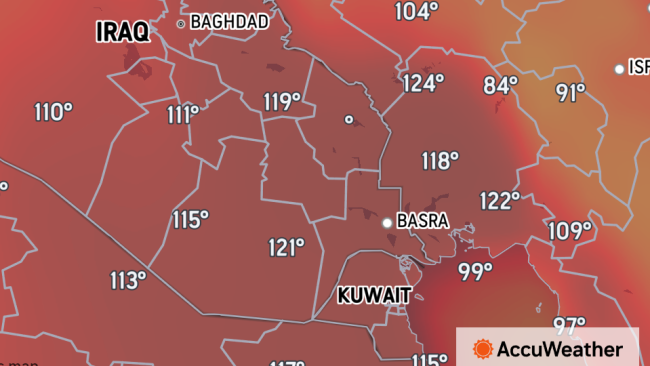Scorching Middle East heat produces 126-degree temperature in Iran

Temperatures skyrocketed across portions of Iraq, Iran and Kuwait early this week as a sizzling mass of air set up shop over the Middle East. AccuWeather forecasters say unseasonably hot conditions began to build across the region over the weekend, but Monday ushered in the peak of brutal heat for many residents.
High temperatures on Monday soared above 122 F (50 C) across portions of Iraq, Iran and much of Kuwait. One reporting station located in Abadan, Iran, topped out at a staggering 126 F (52.2 C) on Monday.
Most of Kuwait, especially locations away from the Persian Gulf, topped out between 122 and 124 F (50 and 51 C) on Monday afternoon. The country's capital city of Kuwait City missed out on the worst of the heat early this week but still climbed to 115 F (46.3 C) on Monday.
Even the coolest reporting station in Kuwait on Monday was brutally warm. A station in Nuwasib, Kuwait, located in the southeastern part of the country near the shore of the Persian Gulf, still managed to record a high temperature of 111 F (44.1 C) on Monday.
 |
This image depicts observed air temperatures on Tuesday afternoon, local time, across portions of Iraq, Kuwait and Iran. (AccuWeather) |
"Brutally hot conditions have expanded across parts of Kuwait, Iraq and Iran recently as a result of high pressure overtaking the region," AccuWeather Meteorologist Alyssa Smithmyer explained.
Due to the location of this area of high pressure early this week, an unseasonably hot mass of air was able to flow directly into this portion of the Middle East. This hot air, when combined with blazing sunshine and dry earth, allows air temperatures near the surface to greatly surpass normal levels.
Forecasters say that while mid- to late June is one of the hottest parts of the year for the Middle East, the extreme dryness of the area has compounded issues recently.
Since March, portions of eastern Iraq, southern Iran and much of Kuwait have only recorded between 0.25 and 0.50 of an inch of rainfall. These areas are typically very dry, but rainfall amounts of this level put many locations at less than 50 percent of normal since the beginning of spring.
If there were more moisture available in the topmost layer of soil across the region, the sun's rays would have to work to evaporate that moisture first, before working to heat up the air. Without the moisture, radiation from the sun is free to heat the air near the surface directly.
This most recent bout of searing heat comes after a prolonged heat wave earlier this month. In early June, portions of Iran, Iraq and Kuwait sweltered through nearly a week of high temperatures well above 120 F (49 C).
An arid and hot climate leaves this portion of the Middle East at risk for other atmospheric threats, including dust and sandstorms. In fact, unseasonable heat at the beginning of the month arrived just after several sandstorms left thousands of residents across Iraq gasping for air.
AccuWeather forecasters say heat across much of Iraq, Iran and Kuwait will ease in the coming days. In fact, some locations can even experience a day or two of cooler-than-average conditions by the end of the week.
Want next-level safety, ad-free? Unlock advanced, hyperlocal severe weather alerts when you subscribe to Premium+ on the AccuWeather app. AccuWeather Alerts™ are prompted by our expert meteorologists who monitor and analyze dangerous weather risks 24/7 to keep you and your family safer.
